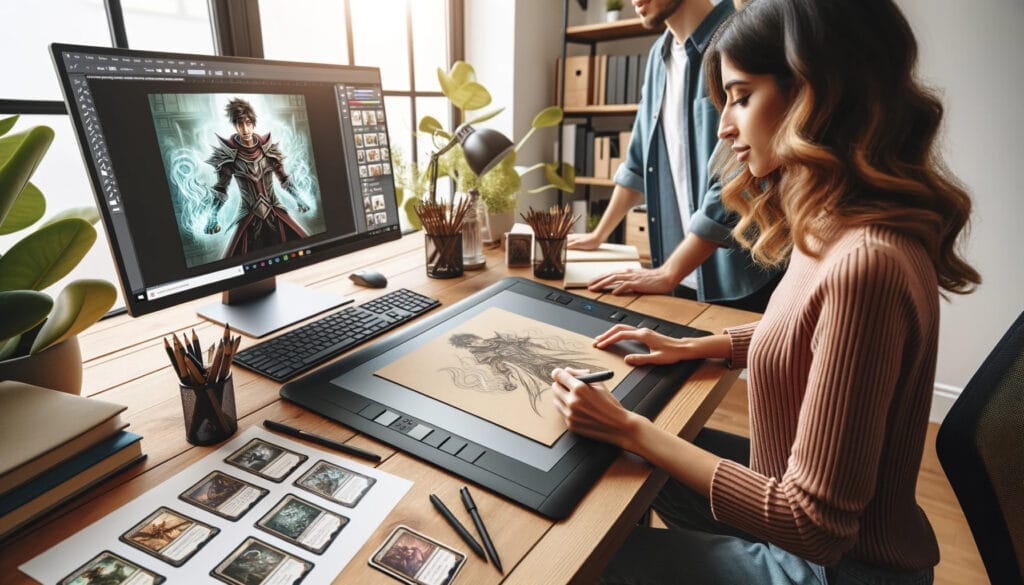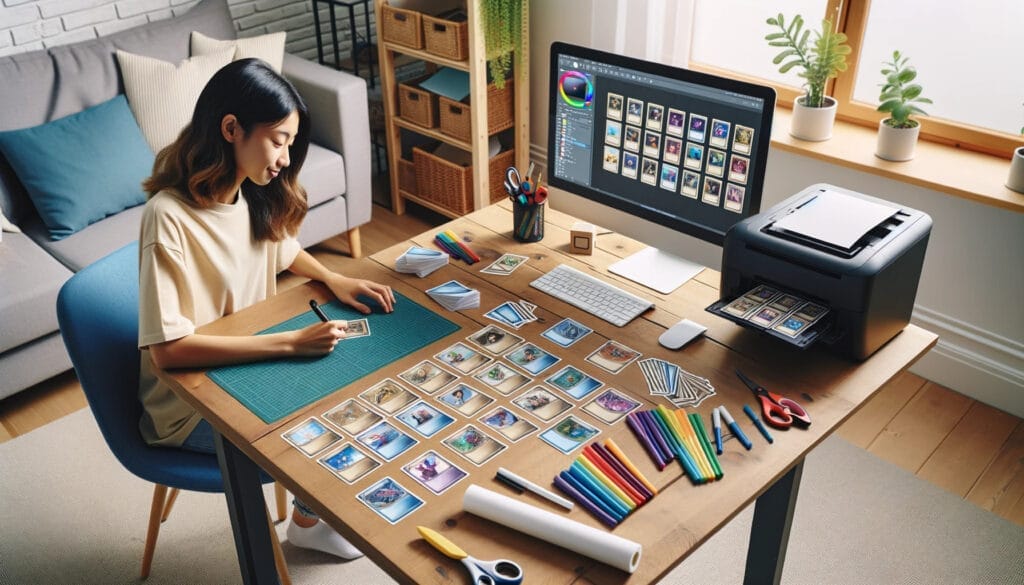
I. Introduction
Trading cards have been capturing the hearts of collectors for generations, becoming a cherished hobby for many. Whether it’s the thrill of pulling a rare card from a pack, the satisfaction of completing a set, or the joy of designing and creating your own unique cards, the world of trading cards offers something for everyone. In this blog post, we will guide you through the exciting journey of how to make trading cards at home and also take you behind the scenes of how they are made in factories. From planning to printing, we’ll guide you on how to make trading cards that are truly your own. Explore the endless possibilities when you make trading cards at home.
From the comfort of your home to the bustling operations of a factory, the creation of trading cards is a fascinating process that combines creativity, precision, and a love for the subject matter. Whether you’re a seasoned collector or a newcomer to the world of trading cards, this guide will provide you with valuable insights and practical tips to enhance your trading card experience. From planning to printing, we’ll guide you on how to make trading cards that are truly your own.
So, if you’ve ever wondered how to make trading cards, or are curious about the process behind your favorite collectibles, read on! This post will not only equip you with the knowledge to start creating your own trading cards, but also give you a newfound appreciation for the craftsmanship and effort that goes into producing the cards you see in stores. Discover how easy it is to make trading cards from the comfort of your own home.
Table of Contents
II. How to Make Trading Cards at Home: A Collector’s Guide

Creating your own trading cards is a fun and creative endeavor that allows you to express your passion and personalize your own collectibles. Whether you’re designing cards for a Trading Card Game, sports memorabilia, or simply for fun, the process can be exciting and rewarding. In this comprehensive guide of how to make trading cards, we’ll walk you through the steps of choosing a theme, gathering materials, designing your cards, and protecting your creations. With just a few simple steps, you can make trading cards that are completely unique to you. Let’s get started!
Step 1: Choosing What Trading Cards to Make
- Begin by selecting a theme for your trading cards. This could be based on your favorite sports team, a beloved movie franchise, or even an original concept.
- Consider your personal interests and the target audience for your cards. What would resonate most with collectors or players? Join the craze and make trading cards that showcase your favorite characters or sports stars.
- Remember that the key to make trading cards specials lies in the passion and love you infuse into their design. Inspire your creativity and make trading cards that reflect your unique style and personality.
Step 2: Materials Needed for Making Trading Cards at Home
- Gather the necessary materials, including cardstock or thick paper as the base for your cards.
- Acquire art supplies such as colored pencils, markers, or paint to bring your designs to life.
- Have scissors or a paper cutter on hand to trim the cards to your desired size.
- Consider using laminating sheets or clear card sleeves to protect your finished cards from damage.
- For added flair, explore special effects materials like glitter, foil, or embossing tools to make your cards truly unique.
Step 3: Designing Your Trading Cards
- Decide on the size and layout of your cards. The standard trading card size is 2.5 inches by 3.5 inches, but feel free to customize it to your preference.
- On the front of the card, place a captivating image or artwork. This could be a photo, a movie poster, or an original illustration.
- Add the card title, which could be the player’s name, the movie title, or any relevant information. Use legible and visually appealing fonts that match your design theme.
- On the back of the card, include additional information such as statistics, a brief description, or fun facts related to the subject of the card. This enhances the overall trading card experience.
Step 4: Assembling and Protecting Your Trading Cards
- Print or draw your design onto the cardstock and cut out the trading card shape using scissors or a paper cutter.
- Add any desired additional details, such as stats or special abilities, to make your trading cards unique.
- For protection against scratches, dirt, and damage, consider using card sleeves specifically designed for the size of your custom trading cards.
Creating your own trading cards is a wonderful way to unleash your creativity and share your passion with others. By following these step-by-step instructions, you can design and produce unique trading cards that reflect your interests and personal style. Harness your artistic talents and make trading cards that captivate and impress. So, embark on this exciting journey today and bring your imagination to life through the world of custom trading cards!
III. How are Trading Cards Made in the Factory

The transformation of a simple piece of cardstock into a vibrant and captivating trading card is a fascinating process that takes place in the heart of a trading card factory. This journey involves a symphony of artists, designers, and machines all working in perfect harmony to create the final product that finds its way into the hands of eager collectors.
Designing Trading Cards in a Factory
The process begins with the design. Professional artists and designers play a critical role in creating the card designs. They work closely with the concept team to bring the vision of the trading card to life. This could involve creating artwork for a new character, designing the layout of the card, or updating the design of an existing card series.
Digital tools are often used in the design process. One such tool is the Wacom Bamboo Slate, which allows artists to draw on a real piece of paper and have their strokes show up on the computer screen. This brings a tactile sensation to the digital design process, allowing artists to create intricate and detailed designs with ease.
Printing and Cutting
Once the design is finalized, it is time for printing. The designs are printed onto large sheets of card stock using high-quality printers. This ensures sharp and vibrant images that make the cards visually appealing .
After printing, the sheets are cut into individual cards. This process requires a high level of precision to ensure that each card is cut to the exact same size, maintaining consistency across the entire card set.
Sorting and Packaging
The cut cards are then sorted into sets. This involves grouping cards together based on their series, rarity, or theme. This step is crucial in creating a cohesive and balanced card pack.
Finally, the cards are packaged into packs, boxes, and cases. This packaging process is not only about protecting the cards but also about creating an exciting unboxing experience for the collector. The anticipation of opening a new pack and discovering what cards are inside is a big part of the thrill of collecting trading cards.
From the initial design concept to the final packaged product, the process of making trading cards in a factory is a complex and intricate one. But it’s this meticulous attention to detail and dedication to quality that makes the world of trading cards so captivating and enjoyable.
IV. How Trading Card Companies Maintain Quality and Consistency

The process of creating trading cards doesn’t end once they’re designed, printed, and packaged. To ensure that collectors receive the best possible product, trading card companies go through extensive measures to maintain quality and consistency throughout their cards. Let’s explore how these companies achieve this.
Overview of the Quality Assurance Process in Trading Card Manufacturing
Quality assurance is a crucial part of the trading card manufacturing process. It involves a series of checks and balances to ensure that every card meets the company’s high standards.
For example, CGC Trading Cards, a well-known grading and certification service, scrutinizes each card for production defects. Depending on the severity and prevalence of a defect, the company will grade the card accordingly. This meticulous process ensures that collectors can trust the quality and grading of their cards.
Maintaining Consistency Across Different Card Sets
Consistency is another important aspect of trading card manufacturing. Companies strive to maintain a consistent quality across different card sets, ensuring that each card, regardless of the set it belongs to, meets the same high standards.
This consistency extends to all aspects of the cards, from the design and printing quality to the packaging. It’s one of the reasons why collectors continue to trust and invest in these cards.
The Role of Technology in Improving Quality and Consistency
Technology plays a significant role in maintaining the quality and consistency of trading cards. Advanced equipment, including devices that perform ultra-microscopic inspections and precisely calculate centering, are used to evaluate cards.
Furthermore, technology aids in the manufacturing process, ensuring that each card is cut to the exact size and printed with high precision. This results in cards that not only look professional but also feel premium in the hands of collectors.
In conclusion, maintaining quality and consistency in trading card manufacturing is a complex process that involves careful quality assurance, a commitment to consistency, and the use of advanced technology. By understanding this process, collectors can appreciate the effort that goes into creating each trading card and trust in the quality of the cards they collect.
V. Biggest Trading Cards Manufacturers

In the vast world of trading cards, several manufacturers have made a significant impact on the industry. These companies have not only provided collectors with high-quality cards but also shaped the landscape of trading cards over the years.
- Upper Deck: Known for its exclusive memorabilia contracts with iconic athletes such as Tiger Woods, Michael Jordan, LeBron James, Wayne Gretzky, Connor McDavid, and Serena Williams. Upper Deck primarily produces NHL cards among the four major sports, along with some golf and entertainment cards.
- O-Pee-Chee: With roots in Canada, O-Pee-Chee started creating trading cards in the 1930s, primarily focusing on ice hockey. They partnered with Topps to release flagship designs with the O-Pee-Chee branding in Canada. Although the company no longer exists today, their name is still used for many Upper Deck hockey products.
- Leaf: Founded in 2010 by Brian Gray, Leaf Trading Cards produces cards in various sports including football, basketball, hockey, baseball, and MMA, as well as non-sport products. They focus on products that center on autographs, providing an affordable option for collectors who want a signature of their favorite player.
- Score: Score first emerged during the late 1980s, known for its bright bordering and extensive player biographics. Originally a subset of Pinnacle Brands, the Score logo is still seen on some lower-end football and basketball products today.
- Sage: Sage Collectibles, a group largely focused on the collegiate sports market, secures autographs of players before they become professional stars. While their cards do not have logos of NCAA teams, Sage products are often sold in major retailers as blaster boxes, which are a cheaper alternative to pricier hobby boxes.
- Choice Sports Cards: This company offers custom trading cards, promotional cards, and collectible trading cards, serving a wide range of clients from individuals to large corporations.
- Epoch: Known for its baseball cards, Epoch is a prominent trading card company in Japan.
- In The Game: Specializing in hockey cards, In The Game is known for its focus on players’ careers and the history of the sport.
These companies, with their distinct characteristics and contributions, continue to fuel the passion of collectors and enrich the trading card industry.
VI. Conclusion
In this journey, we’ve explored the captivating world of trading cards, from the comfort of your home to the bustling operations of a factory. We’ve seen how the passion for a theme can transform into a tangible piece of art at home, and how intricate processes in a factory bring consistency and quality to each card.
We’ve learned about the importance of a well-thought-out design, the careful selection of materials, and the precision required in assembling and protecting the cards. We’ve also discovered the behind-the-scenes operations in a factory, where artists, designers, and machines work together to create the cards we treasure.
Moreover, we’ve delved into the rigorous quality assurance processes that trading card companies follow to ensure the best possible product for collectors, and how technology aids in maintaining quality and consistency.
Whether you’re a seasoned collector or a novice, making your own trading cards can be a rewarding experience. It not only allows you to express your creativity but also gives you a new appreciation for the craftsmanship that goes into every trading card you collect. Take your hobby to the next level and make trading cards that you can be proud of.
So why wait? Gather your materials, unleash your creativity, and start your journey into the fascinating world of trading cards. Happy card-making!






